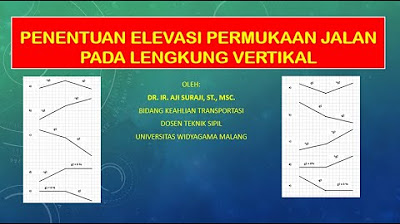3 Membuat Alignment Horizontal
Summary
TLDRThe video transcript outlines a complex road design and planning process, focusing on designing the route alignment, considering curve profiles, and addressing road features like super elevation and spiral curves. It details software usage for road layout, including setting up radius and curves, as well as adjusting the road's width and shoulder specifications. The discussion also involves editing data, improving the accuracy of the project, and managing labels. The design work ensures the road meets both technical standards and practical field implementation requirements, with an emphasis on clear visual communication and precision in planning.
Takeaways
- 😀 Focus on designing road layouts with smooth transitions, especially in curve sections, using spiral curves for better flow.
- 😀 The design emphasizes the importance of **superelevation** (tilting of the road) in curve sections to balance centrifugal forces for safer vehicle navigation.
- 😀 Road width is set at **7 meters** with shoulder adjustments of **3.5 meters** on both sides to ensure safety and proper drainage.
- 😀 Attention to curve geometry: Spiral curves with a radius of **150 meters** are used for smooth transitions from straight paths to curves.
- 😀 The speed limit in curve sections is set to **60 km/h** to ensure safety while maintaining smooth road conditions.
- 😀 The road profile requires careful elevation adjustments to avoid sudden grade changes and ensure vehicle stability throughout the design.
- 😀 There is a focus on accurately marking key objects, including curve radii, traffic markers, and superelevation sections, for manual placement on the blueprint.
- 😀 Alignment and elevation were reviewed to ensure smooth transitions between straight and curved sections of the road.
- 😀 The spiral curve design helps mitigate abrupt transitions between road segments, contributing to overall safety and efficiency.
- 😀 Detailed data entry and manual adjustments are essential, with certain design elements needing review for consistency, such as shoulder widths and curve adjustments.
Q & A
What is the primary focus of the design process described in the transcript?
-The primary focus is on designing a road layout, including alignment, spiral curves, super-elevation, and shoulder width adjustments to ensure safety and efficiency in road construction.
What role do spiral curves play in the road design process?
-Spiral curves are used to provide smooth transitions between different radii of curvature, improving the safety and comfort of the road as vehicles navigate changes in direction.
How is the concept of 'super-elevation' applied in the design?
-Super-elevation refers to the banking of the road at curves to counteract centrifugal forces, improving vehicle stability and safety at higher speeds.
Why is the shoulder width an important consideration in the design?
-Shoulder width is crucial for road safety, providing space for emergency stops, pedestrian paths, and drainage. The design considers a shoulder width of 3.5 meters on both sides.
What is the significance of the radius measurement in the spiral curves?
-The radius of spiral curves determines the smoothness of the transition between straight sections and curves. For example, a radius of 150 meters is mentioned, ensuring a gradual curve for safe driving.
How does the design process account for the road's length and transitions?
-The road's length and the transitions between curves are planned to provide smooth changes in direction, with specific distances like 500 meters noted for ensuring adequate space for vehicle navigation.
What are the tools or software mentioned in the script for designing the road?
-The script references using engineering software tools to simulate and visualize the road's design, including spiral curves, super-elevation, and overall alignment adjustments.
How are the road's geometric features, such as curves and shoulder width, validated in the process?
-The design is checked for consistency with road safety and engineering standards, ensuring the correct curvature, shoulder dimensions, and spiral transitions are met for safety and functionality.
What is the purpose of adjusting the radius and super-elevation during the design process?
-Adjusting the radius and super-elevation ensures that the road curves are navigable at the desired speed, with the correct banking to prevent vehicles from skidding or losing control during turns.
What kind of final adjustments are mentioned for improving the design accuracy?
-The final adjustments involve verifying the accuracy of the spiral transitions, super-elevation, and shoulder width, as well as refining the design through software tools to match safety and engineering guidelines.
Outlines

This section is available to paid users only. Please upgrade to access this part.
Upgrade NowMindmap

This section is available to paid users only. Please upgrade to access this part.
Upgrade NowKeywords

This section is available to paid users only. Please upgrade to access this part.
Upgrade NowHighlights

This section is available to paid users only. Please upgrade to access this part.
Upgrade NowTranscripts

This section is available to paid users only. Please upgrade to access this part.
Upgrade NowBrowse More Related Video

Superelevation - Purpose - Design & How To Calculate It?

[Perencanaan Geometrik Jalan]: Alinyemen Horizontal

Civil 3D - 3: Profil Trase

Curso de topografia | Aula 6 - Perfil Longitudinal, Seções transversais

Penentuan Elevasi Permukaan Jalan pada Lengkung Vertikal

Tutoral membuat corridor jalan di AutoCAD Civil 3d
5.0 / 5 (0 votes)